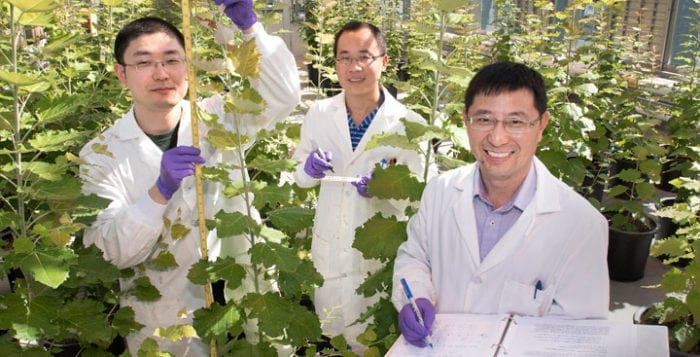BNL’s Liu finds easier way to tap into biofuels

By Daniel Dunaief
It provides structural support, allowing gravity-defying growth toward the sky. While it offers necessary strength, it also makes it more difficult to get inside to convert plant biomass into fuel.
Lignin is the major component that makes cell walls harder. Plants can tolerate the loss of lignin, but dramatically reducing it or altering its structure could severely affect its growth, which makes any effort to modify lignin challenging.
Seeking to balance between the plant’s structural needs and the desire to gain access to biofuel, Chang-Jun Liu, a plant biochemist at Brookhaven National Laboratory, added a step in the synthesis of lignin. “Most studies in this field rely on knocking down or knocking out one or two biosynthetic pathway genes,” said Liu. “We added one more reaction” that competes for the precursors of lignin formation. Liu said he and his collaborators figured that adding that last step in the production of lignin, which is a natural part of plant cell walls, would have the least effect on plant growth while it can effectively reduce lignin content or change its structure.
Liu said he redirected the metabolic precursor by using a modified enzyme he created over the course of several years. The enzyme diverts biosynthetic precursors away from making lignin. Plants typically have three types of lignin, called S, G and H lignin. In a wild-type aspen tree, the ratio of S to G is two to one. This change, however, altered that, turning the ratio to one to two. The general perception is that increasing G lignin would make the cell wall structure stronger and harder, making it harder to release simple sugars. The surprising finding, however, was that reducing S and maintaining G greatly enhanced the release of sugar with digestive enzymes from aspen cell walls.
Scientific partners including John Ralph at the University of Wisconsin and the Great Lakes Bioenergy Research Center confirmed the alteration of lignin structure. Liu tested his enzyme in his earlier work on the flowering plant Arabidopsis. When it worked, he moved on to aspen trees, which grow rapidly and can thrive in environments where typical farm crops struggle to grow. The aspen experiments proved more fruitful in part because these trees contained more S lignin, and the enzyme he developed preferentially blocked the S lignin. The aspen trees with the modified enzyme can yield up to 49 percent more ethanol during fermentation, compared to controls.
Using infrared light at the National Synchrotron Light Source, Liu and his collaborators were able to see an increase in the production of cellulose fibers, which are a primary source of sugars in the cell wall. This may contribute to the release of simple sugars. Liu will continue to explore other possibilities. Other lignin researchers applauded these results.
Liu’s “approach will definitely have a great impact on the cost reduction of cellulosic biofuels,” Dominique Loque, the director of Cell Wall Engineering at the Joint BioEnergy Institute, Lawrence Berkeley National Laboratory, explained in an email. “With no impact on biomass yield and a reduction in recalcitrance, it will reduce the conversion costs of biomass to fermentable sugars.”
While this research, which was recently published in Nature Communications, shows potential commercial promise, Liu and his team are working to answer basic questions. He is interested in further testing his approach in grasses and different trees to determine the effects on lignin content, structure, cell wall digestibility and plant growth. The trees in this experiment were grown in a greenhouse, where scientists could control light and temperature and mimic the natural environment without natural stressors, like insects or fungus. Loque suggested that Liu’s approach can be “easily and quickly optimized to alleviate potential issues such as susceptibility to pathogens” if they exist.
Liu has planted 150 of these altered trees in the field. So far, he said, the biomass yield is not compromised with these experimental plants. “Field tests will allow evaluating the impact of engineering on predators, pathogens and other stresses,” Loque said. Liu was able to create this enzyme after developing an understanding of enzyme structures using x-rays at the NSLS. In that research, Liu was able to gain a better knowledge of how the enzymes that occur naturally worked. Once he knew the structure and method of operation of the enzymes in the lignin pathway, he could make changes that would alter the balance of the different types of lignin.
Liu lives with his wife Yang Chen, a teacher’s assistant in Rocky Point Middle School and their two children, 16-year-old Allen and 14-year-old Bryant. For the last few years, Liu and his family have added hiking, table tennis and tennis to their recreational repertoire.
Liu is encouraged by these findings and is extending and expanding his studies and collaborations. He will work with a Department of Energy sponsored Energy Frontier Research Center. He will also pursue more applied studies to explore the more efficient use of cell wall biomass to produce biomaterials or bio-based products. He is forming a collaboration with Stony Brook’s material science team and with the NSLS-II. “Plant cell wall represents the most abundant biomass on Earth,” Liu said. “Understanding its synthesis, structural property and efficient way in its utilization are critical for our future bio-based economy.”






